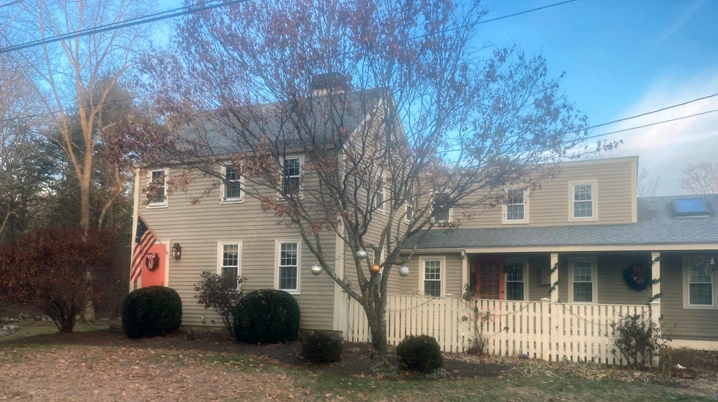John Wheeler moved to Newbury MA by 1650 and obtained considerable acreage at this location. He died in 1662. His son David married Sarah Wise and moved to Rowley in 1669, but maintained possession of the property he had acquired by purchase and inheritance. David’s son Nathan was born in 1669 and purchased a lot along the river from his father to establish a mill. He died in Newbury, age 88 in 1755, presumably at this location. In his will, he deeded 1/3 of his house to his wife Rebecca, and the remainder of the estate to his son Nathan2, who was born in 1701 and is believed to have been the original builder of this house, probably after he married 24-year-old Mary Plumer in January 1724-5.
At a meeting of the freeholders and inhabitants of Newbury, held December 9, 1701, a request by Nathan Wheeler and others was granted for an abatement of their dues to the First Church in Newbury because of the distance they lived from town. On October 13, 1706, Samuel Brocklebank, Jonathan Wheeler, Benjamin Plumer, Nathan Wheeler, John Brown, Andrew Stickney, and their wives, also Mary Chute, and Elizabeth Look, were dismissed from the Rowley church, to join the church in Byfield, sometimes referred to at that time as “Rowlbery.” On October 28, 1710, the General Court ordered that the area around Newbury Falls be set off by Newbury & Rowley, as an acknowledged and established precinct commonly called Byfield.
Nathan, Jr. was given land for a mill and 1/2 of all of Nathan, Sr’s. land in a 1734 filing, then by Nathan Sr.’s will proved in 1741, he received all of his father’s land. In 1799 there was no male heir and thus Nathan, Jr.’s daughters Rebecca Noyes and Sarah Sawyer sold Nathan’s estate to Joseph Pearson. Nathan Jr. had grown the estate from 30 acres to 70 during his stewardship. Thomas Rand Larkin bought the house attached property in 1822 and lived there until he died in 1851. The Story of Byfield Parish notes that “Mr. Horsch’s place was anciently a Wheeler place,” and the 1884 Newbury map shows the Horsch house at this location with its neighbor shown as “C. Noyes.”
Structural observations
The Newbury assessors list a date of 1690 for this house. While some of the frame may be from a pre-existing 17th-century building, structural evidence for the house points to a period of about 1725-30, with a later saltbox addition that was subsequently replaced with a modern ell.
- There is no soffit or frieze board, and the upstairs windows are tight to the edge of the roof, which is found in First Period houses (before 1720), but continues to be found in some houses through the 18th Century.
- Houses in surrounding towns with a similar half-house configuration date to the transitional era between First Period and Georgian, about 1725-1730
- The summer beams were originally cased, are sawn, and have no chamfers, indicating early Georgian construction (after 1725).
- The gunstock posts and girts protrude inside but were originally cased.
- The spacing of the principal rafters in the attic is unusually long, with one on each side but only one in the middle.
- The stone foundation does not perfectly fit the house frame, possibly indicating that parts of an older frame were used.
- The three fireplaces are in the rear center of the house, sitting on a massive stone foundation., were probably added when the house was extended with a shed that no longer exists. The brick chimney is mortared with clay and sand, rather than lime. The bricks appear to be hand-made and are slightly larger than modern bricks. They may be reused, or they may be evidence of an earlier construction date.
- The small kitchen hearth is at the rear of the original building, somewhat similar to a Rumford fireplace, and probably hides a larger original hearth The bake oven and another opening are outside the fireplace on the right.
The Mill
The Larkin Morrill Snuff Mill first operated in the 18th century as a sawmill and was converted to snuff manufacturing by 1804, if not before, when it was bought by Dr. Samuel Tenny who milled snuff until 1811. Between the years 1822 and 1837, Thomas R. Larkin, a “tobacconist”, purchased the mill. His partner in the business was Orlando W. Morrill, hence the name “Larkin Morrill Snuff.” After Larkin”s death, his heirs sold the major interest in the mill, property, and mill rights to Gorham D. Tenny and Daniel Bailey in the decade of the 1870s. In 1899 the mill was sold to the newly incorporated Byfield Snuff Company by Tenny & Bailey who maintained an interest in the company as stockholders.
Sources:
- Descendants of John Wheeler of Newbury Mass
- The history of Rowley, anciently including Bradford, Boxford, and Georgetown, from the year 1639 to the present time – Gage, Thomas
- History of Newbury, Mass 1635-1902 by John J. Currier
- The Story of Byfield Parish by John Louis Ewell, DD
- 1884 Newbury map
- Salem Deeds
- Jack Rybicki
